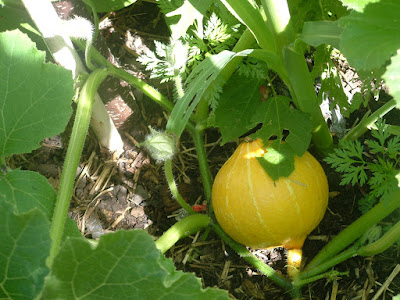 |
| Misc bed in front, Peas and beans behind (with classy DIY runner bean support), Potatoes at the very back, July 2017 |
Roots
Begun harvesting shallots in this bed in July. Most of them have flowered, and the bulbs are small and woody. I'll definitely try growing them again, but make sure to catch them before flowering.
Eating some beets now, both white and red (pretty sure I didn't buy white beet seed! but very tasty). Most still small but growing.
Onions and celery both getting big, but none harvested. Eating carrots in planters gradually.
Peas and beans
Finished and cleared away all peas in this bed: early, maincrop and mange tout; maincrop plants hung up in the garage to dry pods for winter storage. There is still another small batch of maincrop peas in one of the perennial beds, nearly ready this month.
Runner beans and French beans flowering and forming tiny pods, but none harvested in July.
Brassicas
Harvested main heads from two broccoli plants, one small, one medium.
Planted out winter cabbages after peas cleared away, about 18-24 inches apart (really they need about 36 inches, but they'll have to share). Kale and spring broccoli planted out earlier growing well. Rutabagas sown earlier (both batches) growing a bit. A small batch of turnips sowed and some sprouted.
Brussels sprouts in holding bed growing nicely. About half the summer cabbages eaten in July; of the remaining ones, two or three are forming nice compact heads. The leftover Savoys also forming lovely heads.
Miscellaneous
A few cucumbers harvested in July, but plants seem to be diseased: possibly cucumber wilt. Melon plants completely demolished by slugs--none left. Both grown in planters.
Cherry tomatoes forming good trusses of fruit, but none ripened yet. Other tomatoes only just beginning to flower in July. Most tomatoes in planters, but two growing in the main bed. Tomatillos in main bed flowering and forming fruit, but also look diseased. No idea what though--leaves are yellowing and wilting slightly. Hope they survive.
Most squashes and pumpkins planted in the main bed, and two pumpkins in planters. No pumpkins formed yet, but several squashes growing. Plants look strong with good growth and flower formation.
A couple zuccinis harvested at the end of July. One plant very big, the others not as advanced, but just beginning to form fruits at the end of July.
Sweet corn plants still pretty small, but growing. Not sure if they'll have enough time to produce. Leeks still very small. Harvested some radishes, and sowed some more seed.
Eaten pretty much all the bolting chard, now on to the non-bolting chard. So much chard! Eating lettuce leaves still about once a week, and still sowing a few plants in pots. Eating a few spring onions and sowed a few more in pots (now sprouted).
Potatoes
Some potatoes chest high now. I staked them up at the edge of the holding bed. Still growing!
Fruit
Finished Kordia cherries (we had about 6-8, birds had the other 12-15). Finished blackcurrants (tons!), finished gooseberries (lot more than I expected off two 18 inch tall plants), finished raspberries and blueberries (only a handful each), finished last redcurrants and maincrop strawberries.
Alpine strawberries still producing in July, though slowing down. Maincrop strawberries sending out runners, which I will transplant in August or early September.
Plums getting big, apples getting big (only two apples on each tree, sadly). Williams tree has two small pears--I was wrong to doubt you, Williams!
Fig still has three or four big fruits, and forming lots of little ones--probably don't have enough time to mature this year though. Almonds growing well.
Lightly pruned plum, both cherries, Sparta apple, and Williams pear in July. Tied down a few branches on Laxton fortune apple.
Perennials and herbs
Artichokes growing well, and even produced small flowers in July, which I picked off to encourage root growth. Hoping for a good harvest next year.
Asparagus from seed still growing little spindly spears. Chickens ate all the sorrel; hope it's still all right.
Still no sign of either rhubarb plant.
Most herbs still growing well; rosemary still alive after its bit of die back. Thyme and bergamot flowering. Harvested mint just before flowering to make a bottle of mint sauce. Newly sown parsley sprouted. Basil and new dill in pots very small.










